6 Best Cable Fly Alternatives (with Pictures!)
As effective and popular as cable flys can be, lifters often complain of difficulty maintaining proper form or that they simply do not have access to a two-sided cable machine.
The easiest way to address these issues is to simply select an alternative exercise of similar benefits as a substitute to the cable fly.
What are Cable Flys - And Why Substitute Them Out?
Cable flys are a machine-based isolation exercise primarily performed to target the chest with high volume low impact sets.
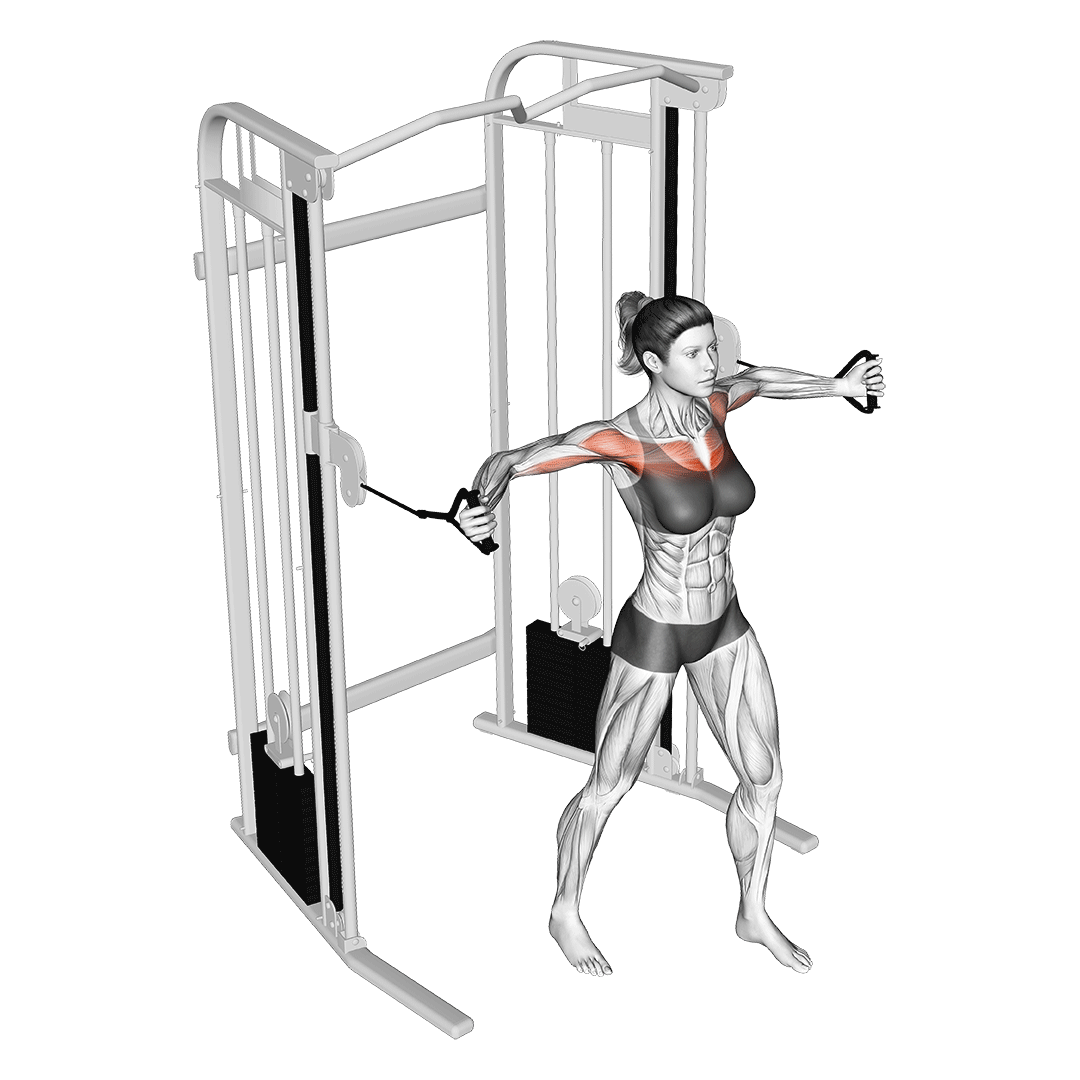
However, this low impact machine-based nature means that cable flys are somewhat inconvenient for home gym lifters or those that wish for a somewhat more intense chest isolation exercise.
Other common complaints with cable flys are a comparatively small range of motion, the fact that they need to be performed upright or that the lifter feels the exercise targets their biceps more than their chest.
What to Look for In a Cable Fly Alternative
Cable flys are primarily an isolation exercise of the pectoral muscles, featuring arm adduction near chest-level as the main mechanic of the movement.

Any suitable alternative should share these characteristics, as well as a similar level of intensity (if needed), a similar range of motion and the same role within your training program.
Based on these criteria, we can eliminate more common chest movements like the bench press, dip or conventional push-up as they are simply too different to fulfill the same role as cable flys. Instead, movements like pec decks, dumbbell chest flys and slider push-ups are more appropriate.
Cable Fly Alternatives
1. Pec Deck Machine
The pec deck is a similarly machine-based isolation exercise meant to target the chest through arm adduction against resistance.
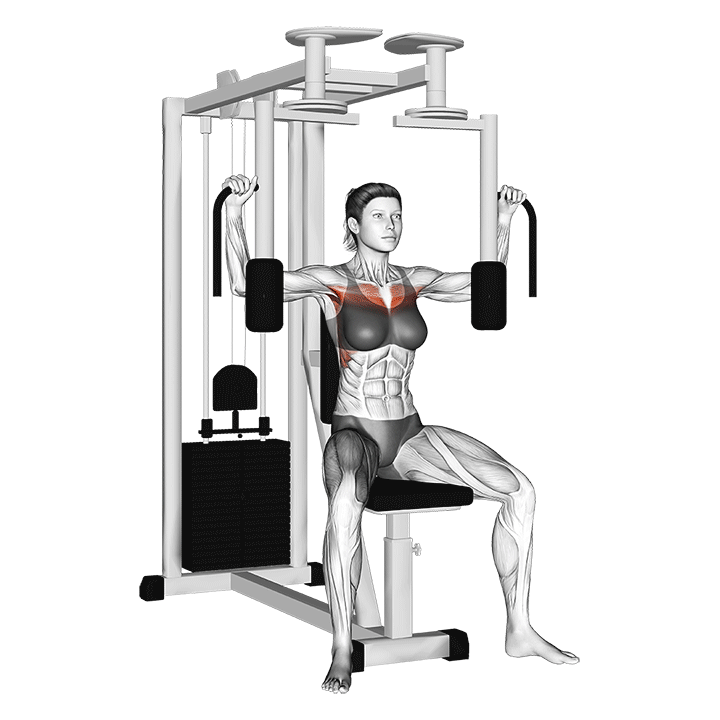
Rather than using a cable machine, pec decks require the use of their own dedicated piece of equipment - where the lifter will be seated behind a pair of handles and elbow pads with the torso in an upright position.
As a cable fly alternative, pec decks are ideal for situations where the cable machine is unavailable or a more fixed range of motion is needed. Otherwise, they are practically identical as far as general mechanics and muscular recruitment are concerned.
Equipment Needed
Pec decks will require a pec deck machine.
Sets and Reps Recommendation
The pec deck and the cable fly are identical in terms of intensity and complexity. Simply transfer whatever your previous programming was to the pec deck.
However, a good starting place for novices is 2-3 sets of 12-16 repetitions at a low level of resistance.
Common Mistakes to Avoid
Avoid leaning forwards while performing pec decks, as this can strain the shoulder joint and shift emphasis to the anterior deltoids.
Furthermore, pec decks will feature a more strict path of the arms than cable flys. Ensure the machine is adjusted to meet your individual proportions.
How-to:
To perform a repetition of the pec deck, the lifter will seat themselves within the machine, hands gripping the handles at both sides. For greater chest contraction and less shoulder impact, use a neutral grip.
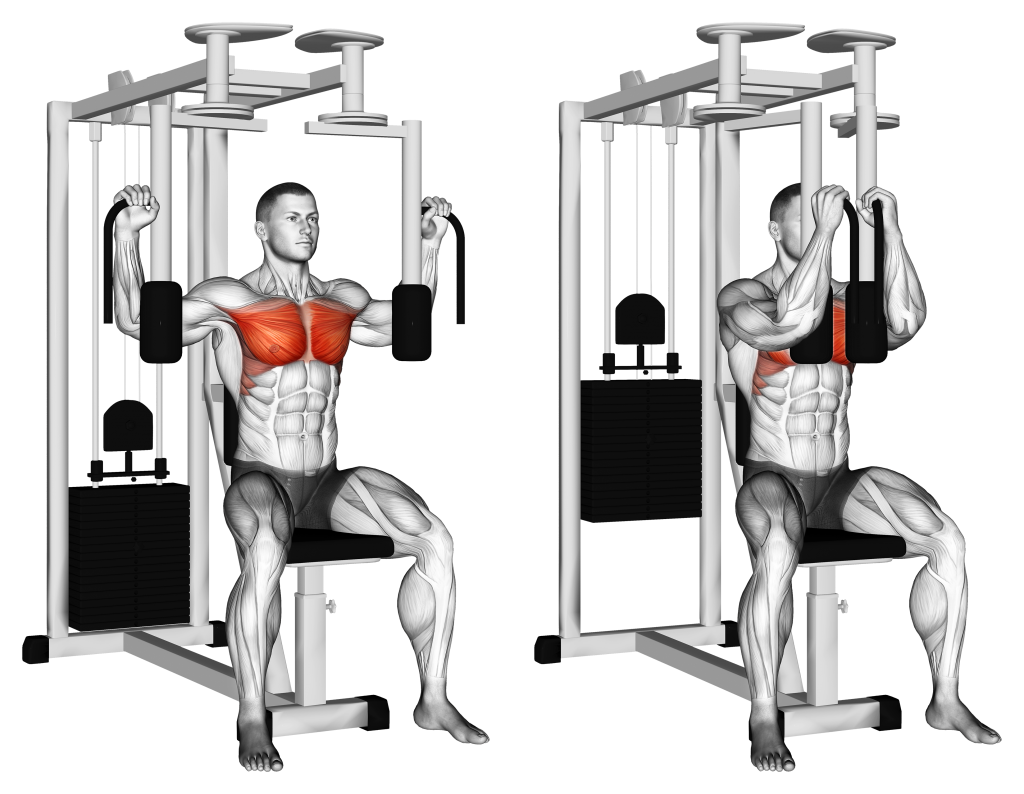
Now positioned correctly, the lifter will retract their scapula, roll their shoulders into a neutral position and pull their hands towards the midline of the body. The elbows should be ever so slightly bent, avoiding full extension.
Once the hands are nearly touching each other at the front of the torso, the lifter slowly releases tension from their chest as the resistance of the machine pulls their hands apart.
When back in the starting position once more, the repetition is considered complete.
2. Cable Crossovers
Cable crossovers are a close substitute of the cable fly where the lifter performs an otherwise ordinary fly before extending the movement and crossing one wrist over the other.
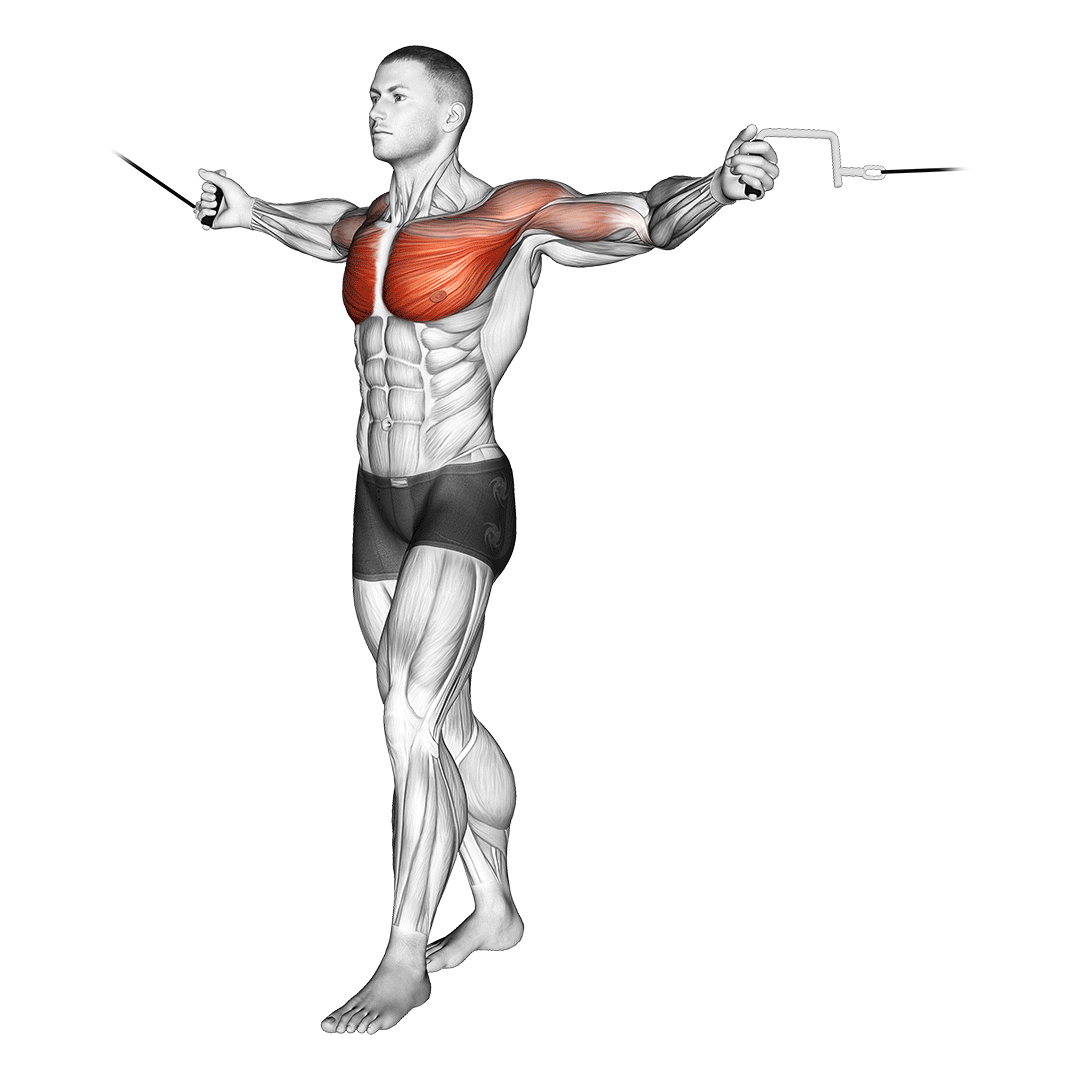
In all other aspects - muscular recruitment, movement pattern and intensity - the cable crossover is identical to the cable fly.
The sole difference between the two lies in range of motion and wrist orientation, where the former is somewhat larger in range and uses a pronated grip. This improves the extent to which the pectoral muscles are targeted in both a ROM and positioning aspect.
Equipment Needed
Cable crossovers require much the same equipment as cable flys - that being a double tower cable machine and a pair of D handles.
Sets and Reps Recommendation
Perform cable crossovers to the same resistance and volume as you would cable flys.
As a baseline, 2-3 sets of 12-16 repetitions is suitable for the majority of weightlifters.
Common Mistakes to Avoid
Remember to switch which arm crosses over the other with each repetition.
Avoid forward rounding the shoulders as you do so, as this can lead to irritation of the inner portion of the shoulder joint.
Lean slightly forwards at the hips to maximize pectoral contraction and avoid losing your balance as you perform the set.
How-to:
To perform a repetition of the cable crossover, the lifter will attach a pair of D handles to both cable towers, holding them in their hands at arms length as they stand within the center of the cable machine. The wrists should be pronated, with the elbows slightly bent throughout the repetition.
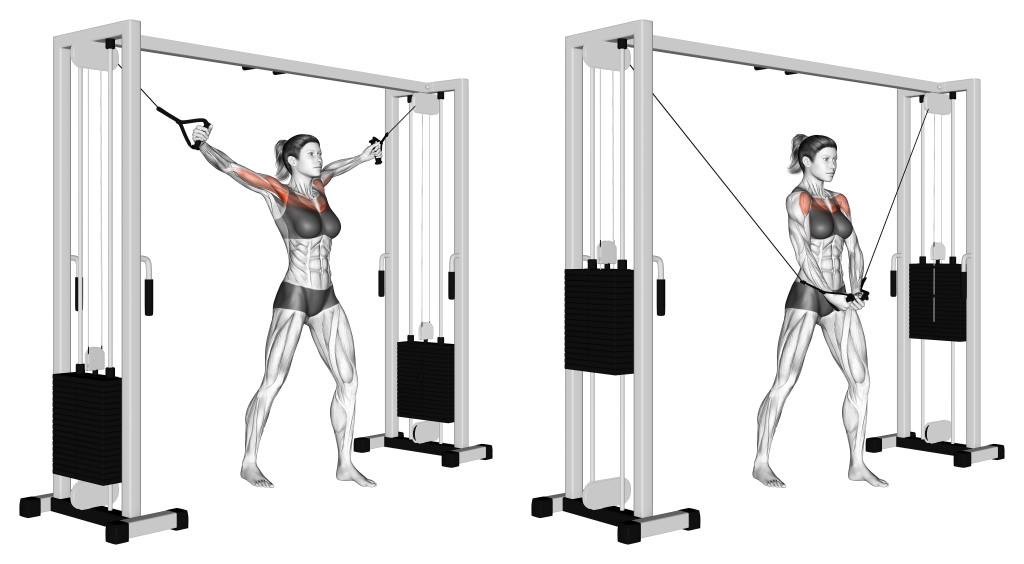
Leaning slightly forwards at the hips, pushing the chest out, facing the head forwards and rolling the shoulders into a neutral position, the lifter then proceeds to pull their hands together against the resistance.
As their hands come close to touching, the lifter then crosses one hand over the other, squeezing their chest as they do so.
Now at a full range of motion, the lifter slowly releases the tension in their chest and allows the resistance of the cables to pull their arms back out to the sides in a controlled manner. The repetition is now considered complete.
3. Dumbbell Chest Flys
For a more free weight geared alternative, dumbbell chest flys function in much the same manner as cable flys - that being a pectoral isolation exercise meant for high volume, a large ROM and generally low resistance.
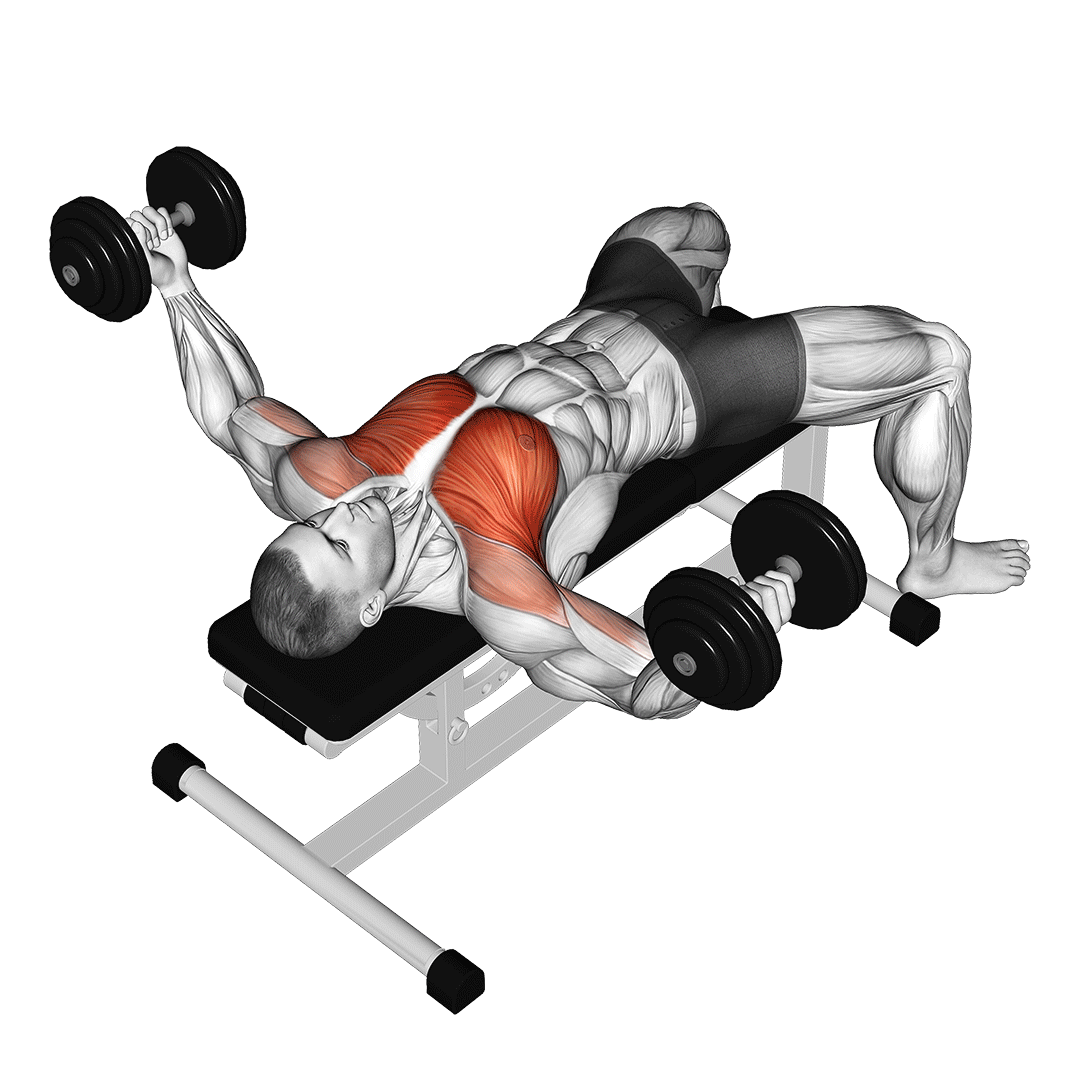
However, on account of them being a free weight exercise, dumbbell chest flys are significantly more effective at building functional chest strength and isometrically contracting muscles like the triceps brachii and the anterior deltoid heads.
Use dumbbell chest flys as a cable fly alternative if you do not have access to a cable machine, or are seeking a more intense, taxing and functional substitute.
Equipment Needed
Dumbbell chest flys will require a pair of low or moderate weight dumbbells and an exercise bench.
Sets and Reps Recommendation
Dumbbell chest flys are somewhat more taxing than cable flys.
As an accessory movement, they are best programmed for 2-3 sets of 8-12 repetitions at a moderate amount of weight.
Common Mistakes to Avoid
Keep a slight bend in the elbows so as to avoid straining the arms and shoulders. Ensure that the arms are drawn from a position parallel to the torso to one above it at near full extension.
In addition, ensure that a small arch in the lower back is present and that the scapula is retracted beneath the body while lying atop the bench.
How-to:
To perform a repetition of dumbbell chest flys, the lifter lies on their back with their shoulder blades pinned against the bench and a small arch present in their lower back. The feet should be flat on the floor beneath them.

In this stance, the lifter spreads their arms outwards as they hold a pair of dumbbells in a neutral grip, contracting their chest so as to draw the arms together.
With the arms now extended over the chest and the dumbbells nearly touching, the lifter then simply reverses the motion in a slow and controlled manner - thereby completing the repetition.
4. Banded Chest Flys
In cases where absolutely no equipment other than a resistance band is available, lifters can choose to perform the resistance band variation of chest fly.

Like the cable version, banded chest flys are performed so as to isolate the pectoral muscles through adduction of the arms.
However, the use of a resistance band comes with the additional benefit of being able to control the distribution of resistance throughout the range of motion. Lifters can stand closer to the anchor point of the band so as to gradually increase resistance as their arms are drawn closer together.
Outside of this rather niche benefit, the banded chest fly is best used in situations where no cable machine (or any other form of equipment) can be used.
Vacations, pre-bodybuilding show pump-ups and small home gyms are where lifters will benefit most from the light weight and convenience of a resistance band.
Equipment Needed
Banded chest flys require only a single resistance band, although a pair may make performing the exercise easier.
Sets and Reps Recommendation
Aim for a lengthy time under tension. 2-3 sets of 10-16 repetitions should suffice.
Common Mistakes to Avoid
Remember to pick a suitably sturdy anchor point for the band - especially one that is angled parallel or above the torso, as this will provide the ideal angle for performing chest flys.
Avoid rushing through the repetition, as the main benefit of resistance bands comes in the form of tension over an extended period. Slow down the tempo of the movement, especially in the eccentric portion.
How-to:
To perform a repetition of the banded chest fly, the lifter will first affix the center of the band (or bands) to an anchor around chest level behind them.
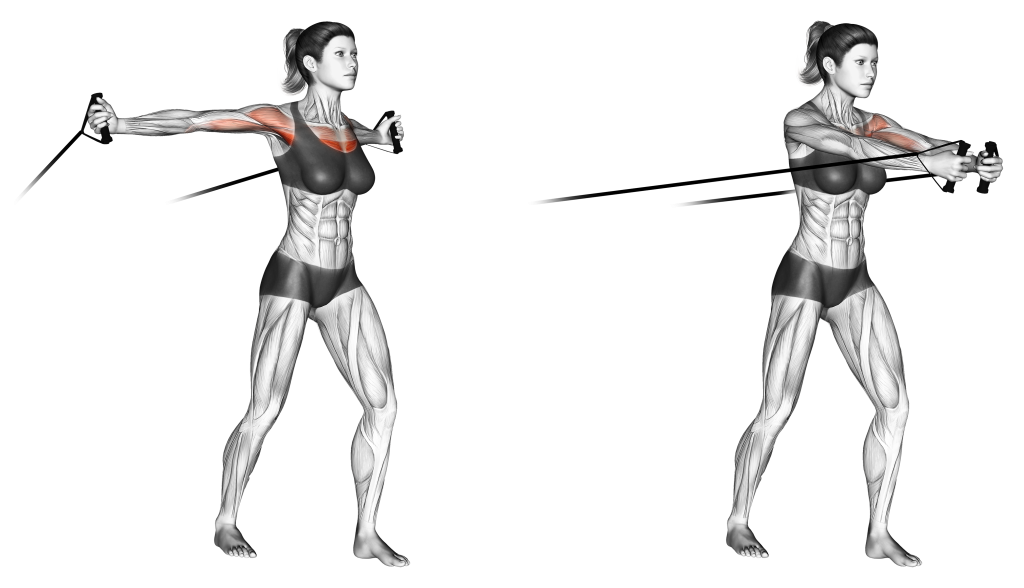
Gripping the ends of the band in both hands, they then step far enough away to create tension in the band at the start of the repetition. Of course, skip this step if performing this exercise to correct sticking points or for other technical purposes.
Now standing upright with the ends of the band held in both hands, the lifter raises their arms out to the sides, faces their head forwards, pushes out their chest and positions their shoulders neutrally.
From this position, the lifter pulls their hands together at the front of their chest, keeping the elbows slightly bent as they do so.
Once the hands are touching, they then reverse the motion in a slow and controlled manner, resisting the tension in the band. When back in the starting position, the repetition is now considered complete.
5. Slider Push-Ups
Slider push-ups are a unique variation of push-up where a pair of sliders are placed beneath the palms, requiring the lifter to outwardly rotate their arms as they perform the push-up. This creates the opposite sort of movement pattern to the cable fly - rather than adduction against resistance, it is instead abduction.
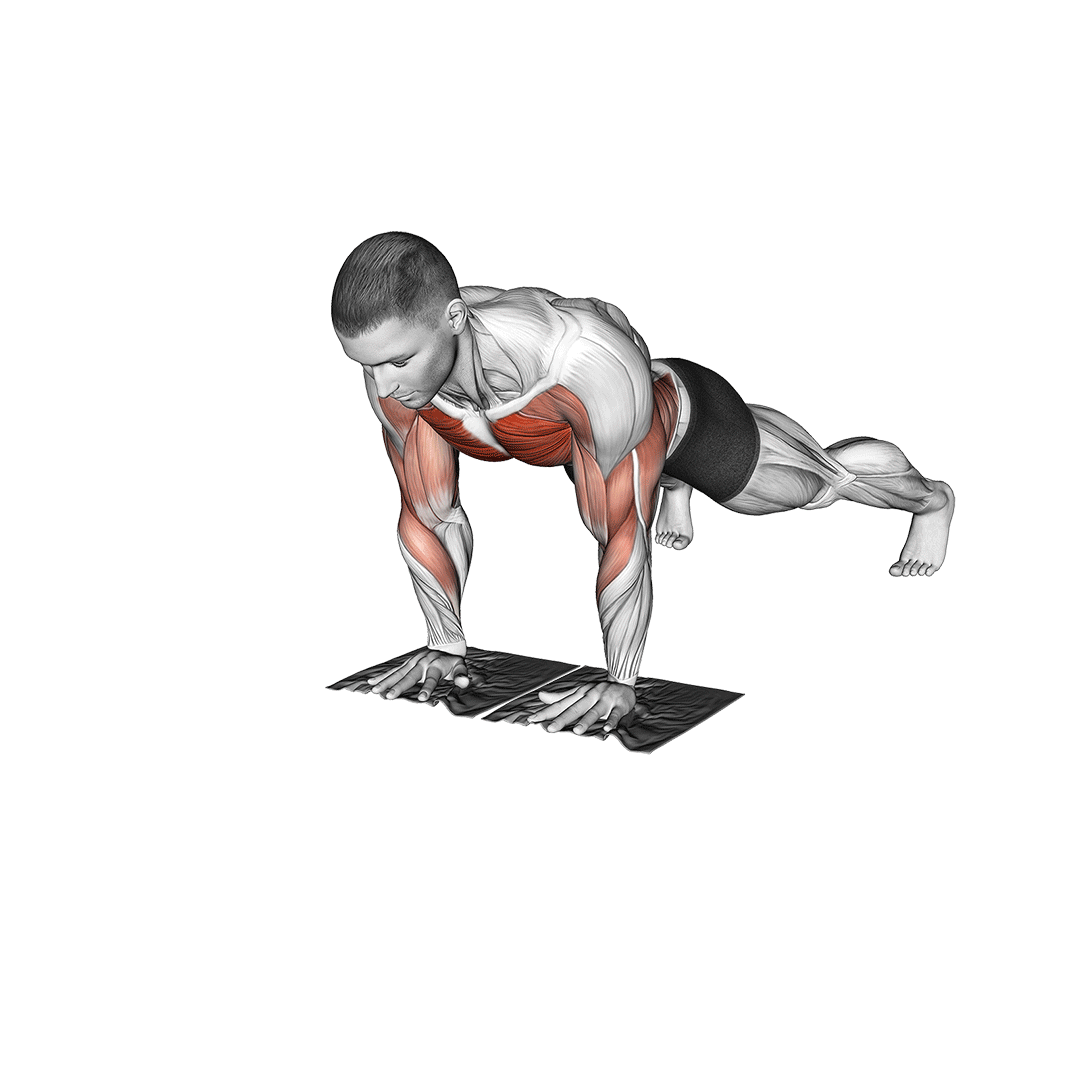
In addition, slider push-ups are less an isolation exercise and moreso a general compound push movement.
Muscles like the triceps brachii and deltoids are trained in a similar capacity to the chest, requiring restructuring of the training program.
Slider push-ups - like band chest flys - are a situational substitute exercise to cable flys when no access to a cable machine is present.
Equipment Needed
Slider push-ups require a pair of sliders and a suitable surface to use them on.
Sets and Reps Recommendation
Because slider push-ups are considerably more taxing and heavier than cable flys, aim for 2-3 sets of 6-10 repetitions.
Common Mistakes to Avoid
Externally rotate the shoulders alongside the arms, as internally rotating them as the arms abduct can create significant tension in the shoulder joint.
If the exercise is too difficult, try performing the movement on your knees, rather than in a plank stance.
How-to:
To perform a slider push-up, the lifter will begin by entering a standard push-up stance with their back flat, core contracted and hands set parallel to the shoulders. A pair of sliders should be placed beneath both palms.
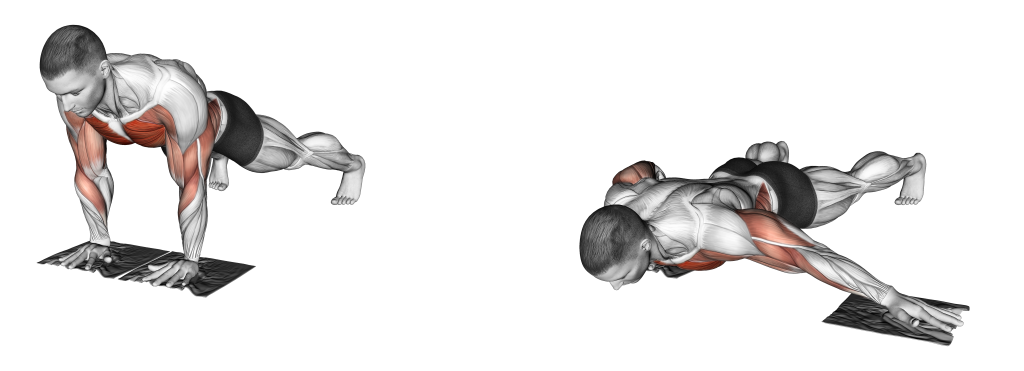
Lowering their chest towards the floor as with a regular push-up, the lifter then slowly creates pressure on the inner side of their palm so as to slide their hands (and the sliders) out to the sides.
Maintain tension when doing this, as it may cause you to suddenly drop towards the ground.
Once the arms are spread wide and the chest nearly touching the ground, the lifter then contracts their chest and simultaneously draws their arms together as they push off the ground - returning to the original position.
When back in the original position, the repetition is considered to be complete.
6. Band Chest Press
The band chest press is a compound resistance band exercise targeting the chest, triceps and anterior deltoids.
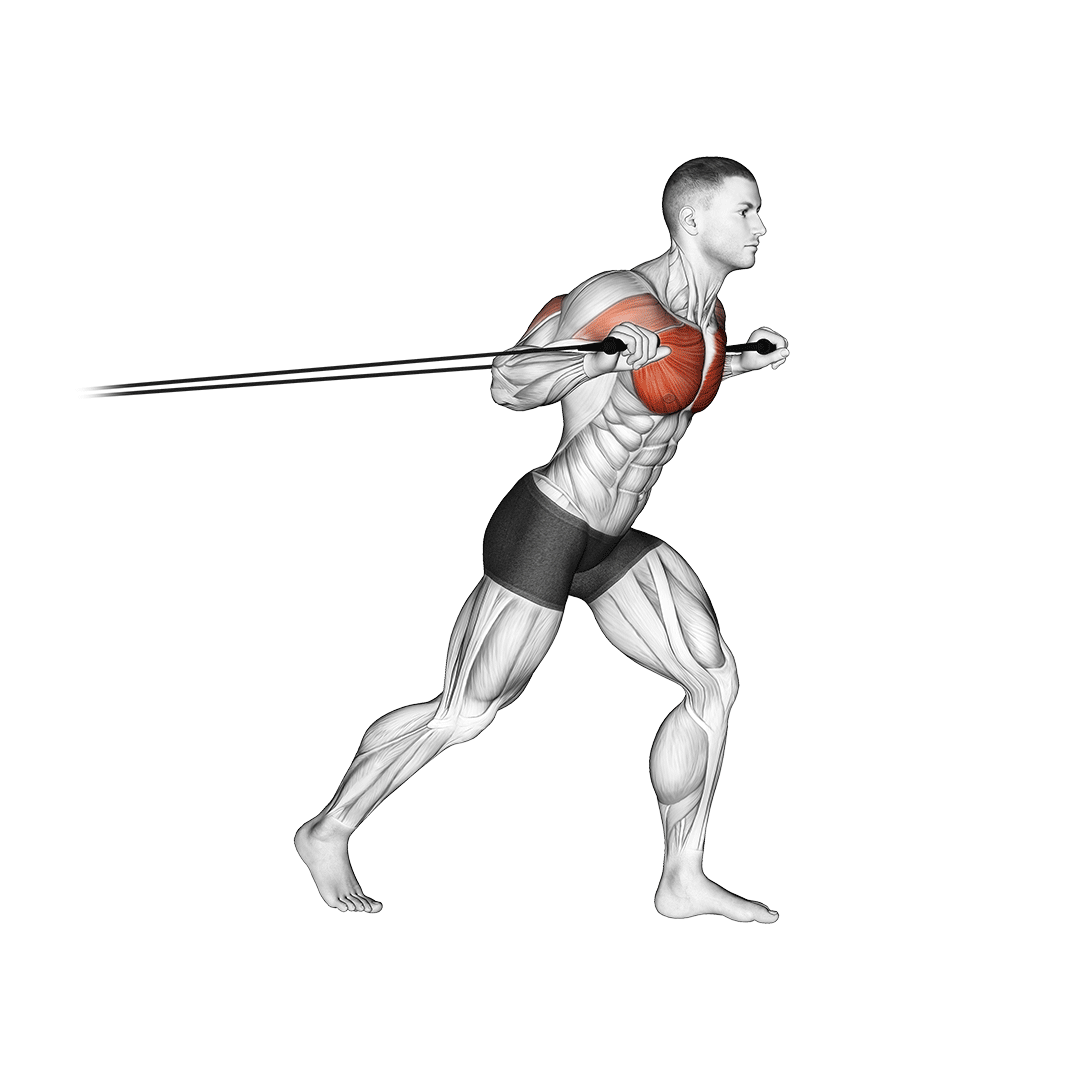
As a cable fly alternative movement, they are best used in situations where the lifter both has no access to other forms of equipment and if they wish to avoid excessive arm rotation due to shoulder discomfort.
If both criteria are not met, it may be better to perform banded chest flys instead. The chest press will target more muscles at a greater intensity, requiring alteration of the workout program to compensate.
Equipment Needed
The band chest press will require a single resistance band.
Sets and Reps Recommendation
Because banded chest presses are more intense and target more muscles than cable flys, aim for 2-3 sets of 6-10 repetitions at a moderate level of resistance.
Common Mistakes to Avoid
Press the arms forwards at a level below the shoulders, rather than above them. Use a pronated grip for greater triceps and chest engagement.
How-to:
To perform a repetition of the band chest press, the lifter will attach the center of a band to a stable anchor above their head, gripping both ends and turning to face away from the anchor.

Tilting forwards at the torso, the lifter then contracts their chest and pushes the ends of the band ahead of their body, extending their arms until straightened.
Once both arms are fully extended, the lifter then slowly allows the resistance of the band to pull their elbows back behind their body - thereby completing the repetition.
Which Cable Fly Alternative is "Best"?
The best alternative to cable flys is one that retains as close a movement pattern and set of benefits as possible.
Pec deck machines, banded flys or dumbbell chest flys are ideal as a substitute - but those with special training needs or a lack of equipment may need to perform less similar exercises.
Remember that the cable fly is almost invariably performed for high-volume low-intensity sets in the pursuit of pectoral muscle hypertrophy. Exercises that only incidentally target the chest (or those too taxing for high volume) may not be the most appropriate alternative.
If you haven’t found a suitable exercise in this article, look into variations of the cable fly or less similar chest isolation exercises instead.
References
1. Soncin R, Pennone J, Guimarães TM, Mezêncio B, Amadio AC, Serrão JC. Influence of exercise order on electromyographic activity during upper body resistance training. J Hum Kinet. 2014 Dec 30;44:203-10. doi: 10.2478/hukin-2014-0127. PMID: 25713681; PMCID: PMC4327372.
2. Solstad TE, Andersen V, Shaw M, Hoel EM, Vonheim A, Saeterbakken AH. A Comparison of Muscle Activation between Barbell Bench Press and Dumbbell Flyes in Resistance-Trained Males. J Sports Sci Med. 2020 Nov 19;19(4):645-651. PMID: 33239937; PMCID: PMC7675616.
